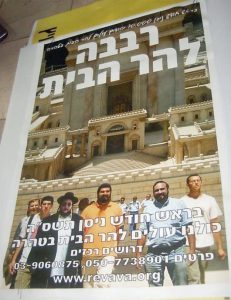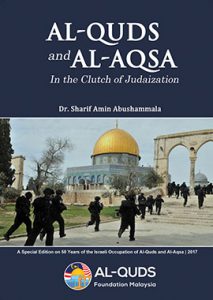By: Majd Al-Hadmi
Translated and modified by QFM
The history of reading the Quran in al-Aqsa Mosque started from Al-Iqraa School in the Levant al-Sham and it is attributed in its origin to the companion Abu Darda (ra), one of the people who gathered the Quran in the era of the Prophet Mohammed (pbuh) and that time he was a judge on al-Sham in 32 AH.
Al-Quds is proud of its unquestioning interest in the Holy Quran whether recitation, education and Quranic Sanad. It embraces al-Aqsa Mosque, which opened its gates to the Islamic scientists and the students throughout history. Al-Aqsa Mosque was the only great scientific institute in al-Quds in the first four centuries of prophet migration. It is the mosque and the school where the science of Fiqh, Hadith and Quran comes from.
The Crusader occupation caused a decline of the Islamic scientific influence of al-Quds but it returned again and strongly in the Ayyub id, Mamluk and Ottoman periods. During these periods, the rulers of al-Quds took a keen interest towards education and were keen to be honored to visit it, especially during the pilgrimage seasons. It’s clearly noticed in the biography books that students from all over the Islamic states sought to visit the scholars living in al-Quds to benefit from their great knowledge, including the sciences of the Quran and Sanad -the bond between the reader and his teachers to the Prophet (pbuh)- through readers who read the Holy Quran in al-Quds. There were a number of readers who worked in al-Aqsa, including Shahabuddin Ahmed bin Mohammed bin Mughith Alandalusi, Sheikh Othman bin Abdullah bin Abdul Rahman Abu Omar al-Jabrati, and the head of readers in al-Quds, Sheikh Shihabuddin Ahmed, the son of Sheikh Shams al-Din Muhammad bin Mohammed bin Hussein al-Awtari Al-Shafei who passed away in 874 AH / 1469 AD.
There is a great mention in the biography books of al-Aqsa readers which is not limited to the readers who have read at al Aqsa during history, or those who were born in al-Quds, lived in it, or died there. We can’t mention them all due to their large number but we will mention some of them like; Imam al-Nasai, the author of “Alsunn Alkubraa Walsughraa”, whom the people know as a scholar of Hadith and they do not know that he read and recited the holy Quran at al-Aqsa and he died in 303 AH / 915 AD. As well as the famous Imam al-Razi, who used to read the Quran and teach it in the Dome of the Rock in the fourth century AH, and one of his disciples was Abul Abbas, al-Nasawi, the Imam of Masjed al-Haram during that time. The first imam of the Dome of the Rock after the conquest was Andalusian and known as Alhaj al-Malqi and his name was Abul Hassan Ali bin Jameel Maafri al-Maqdisi, studied in Morocco then moved to Damascus when he was still young man and learned from its scholars. After that, he lived in al-Quds to lead the people in their prayers and to teach them the holy Quran. He died in 605 AH / 1208 AD. Thereafter, the habit of reverence of Hajj has spread out, which some pilgrims were keen to adhere to. It means visiting al-Quds after performing Hajj. This habit had a good effect on the scholars’ stay in al-Quds and on the flourishing of the scientific movement there, especially the Moroccan pilgrims who used to take the opportunity to travel to al-Aqsa Mosque because they may not be able to pray there again because of the far distance.
Some of them decided to stay in al-Quds in their neighborhood which is still known as the Moroccan neighborhood (Harat al-Maghariba) to learn the Islamic sciences from the scholars of al-Quds, including Abdullah bin Mohammed al-Maghribi who used to recite the holy Quran and teach it at al-Aqsa Mosque and he stayed there until he died in 710 AH / 1310 AD.
Shehabuddin Ahmad ibn Jabara al-Maqdisi al-Salhi, one of those who were affected by the Crusaders occupation of al-Quds in 1099, his family migrated to Syria until he returned to al-Quds in the seventh century AH. He became one of the most famous readers and schoolers of the sciences of the holy Quran. He lived there until he died in 728 AH / 1327 AD. In addition, Imam Muhammad ibn al-Jazri was considered as one of the most famous sheikhs of the Quranic readings in al-Aqsa Mosque. Ibn al-Jazri travelled between the Sham, the Hijaz, Egypt and Iraq, learning the Quranic readings and teaching them to the people. Sheikh al-Islam Shehabuddin sent him an invitation to visit Bait al-Maqdis and he responded to him and stayed there for the rest of his life until he died in 833 AH / 1492 AD. He was the head of al-Jawharia school and al-Salahia school in al-Quds. Also, he was assigned as an Imam to recite the Quran of Zaher Jumqaq at the Dome of the Rock.
The continuance of reading of the holy Quran in al-Aqsa Mosque throughout the year
The Mamluks (who ruled the Sham between the thirteenth and sixteenth centuries) dedicated a function to the reader of the Quran, which we call today the reciter, which is based on reading the holy Quran, reciting it at certain times of the day and explaining the meanings of the verses Aya to a group of people in mosques.
The appointment of the reciter was accompanied by giving copies of the Quran to the mosques. The rulers and the governors were competing to send copies of the holy Quran to al-Aqsa Mosque to be read there at all times without interruption. One of the manifestations of this care is what some of the Mamluk sultans did to honor the Holy Quran. Sultan Toman Bay placed a copy of the Quran inside the mosque of the Dome of the Rock towards the mihrab. He appointed Shaikh Muhammad ibn Qatlubgha al-Ramli as the reciter and he was a famous reader with strong memory and good voice. One of the copies that was given to al-Aqsa Mosque is Mushaf al-Nafis, the copy of Sultan of Morocco, “Abulhassan El-Marini”, which is kept in the Islamic Museum at al-Aqsa Mosque. Where the Sultan gave three copies to Masjed al-Haram, Masjed al-Nabawi and al-Aqsa Mosque, the first two copies were lost and only the copy of al-Aqsa Mosque has remained in the entire Islamic world. A number of Moroccan readers have been appointed by the sultan to read this Quran in the mosque.
One of the pages of the Mushaf of Abu Hassan Marini in Moroccan Kufic script
This situation continued during the era of the Ottomans. Since the beginning, they have been interested in sending the honorable Musafs and placing them in the vaults of the Dome of the Rock, al-Aqsa Mosque and other institutes of Islamic science in al-Quds.
They also employ readers to recite the holy Quran as their predecessors did. It is worth mentioning that the manuscripts and the records of the Islamic courts in al-Quds are filled with the names of the readers who have turned to recite from the Qurans that were given in the successive periods in an indication of the continuous of reciting the holy Quran in al-Aqsa Mosque and its mussalas. As for the completion of reciting the Holy Quran, it has continued to this day. The reciters in the twenty-eighth of Ramadan conclude each year with reciting the 30th chapter, and this occasion is usually attended by the worshipers and a number of the people of al-Quds. In the picture:
The Palestine newspaper chronicles the ceremony of concluding recitation of the holy Quran inside the Dome of the Rock in Ramadan 1365 AH, August 1936.

